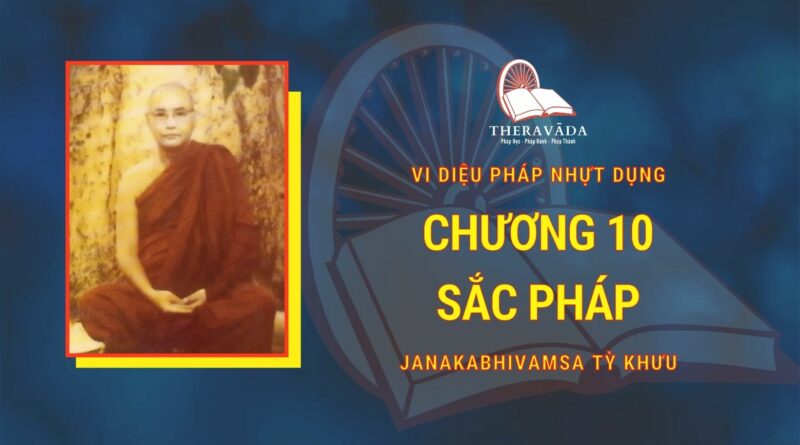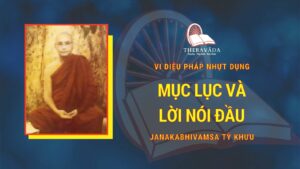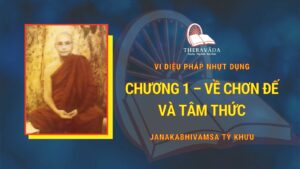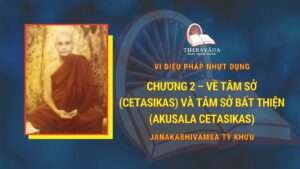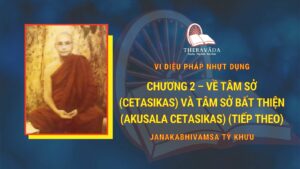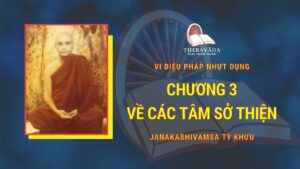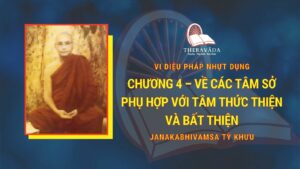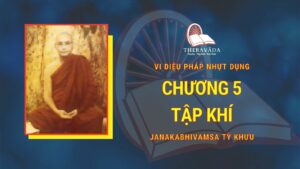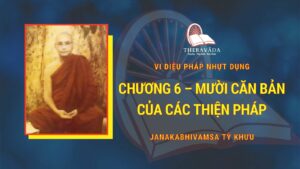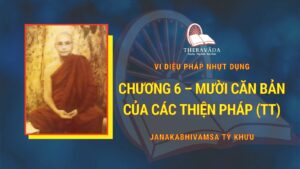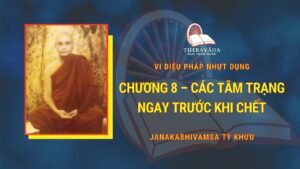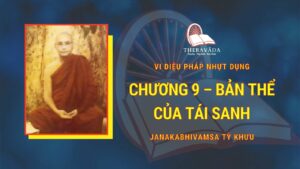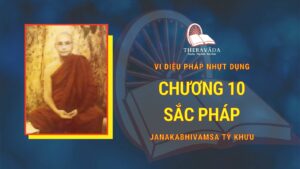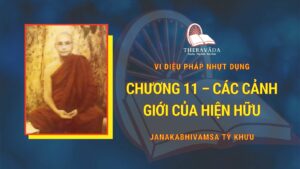Nội Dung Chính [Hiện]
ALBUM ẢNH THUMB – ASHIN JANAKABHIVAMSA TỲ KHƯU
Album Ảnh Thumb Cuốn Vi Diệu Pháp Nhựt Dụng – Tỳ Khưu Janakabhivamsa
Vài Dòng Tiểu Sử Ngài Trưởng Lão Ashin Janakabhivamsa Sayadaw
The boy who was to grow up to become a celebrated teacher of Pali Scriptures and the Abbot of the famous Mahagandharama Monastery of Amarapura, Mandalay Division, was born on Tuesday the fourteenthth waning day of Tabodwe 1261, ME. (27 February 1900) of U Zaw Ti and Daw Ohn Hline in Tha-yine village, Wetlet township, Shwebo district, Sagaing Division.
In 1266, when he was five years old, he was sent to the local monastery and was initiated for the first time in accordance with traditional custom into the Order of the Samgha as a novice, samanera. Nine years later in 1275 when he was initiated for the second time into the Order, it was to spend his life-time as a disciple of the Buddha in His Dispensation.
At the age of eighteen in 1279 M.E. (1918) while he was still a samnanera, he passed the Government examination at the higher level Pathamagyi.
When he came of age he was ordained a full-fledged Buddhist monk with the title of U Janaka on the Full-moon day of Tabaung 1280 M.E. (1919). He had the distinction of being ordained thrice in his life, the second time on the Full-moon day of Nayon 1281 M.E. (1920) and the third on the Full-moon day of Tabaung, 1281 M.E. (1920).
His preceptor saw to it that he studied under the best teachers in the two most prominent centres of Pariyatti learning in Myanmar, namely, Mandalay and Pakhokku. The advanced courses in the Pali Canon, the Commentaries, Sub-commentaries, exegeses, and expositions were thoroughly learned from the most distinguished teachers of these centres where he was afforded the opportunity of acting as a probationary teacher himself under their guidance.
Thus to pass the Government Pathamagyaw examination in 1287, standing first, and to gain outright success in the specially difficult Sakyasiha-Lecturershipexamination in 1289 for the title of Pariyattisasanahita Dhammacariya were for him just matters of routine.
By that time he had already started launching his whole time job of writing books which were to be useful guides and manuals for his thousands of students who later gathered round him till he passed away. He also wrote many small manuals for lay Buddhists who have no opportunity to study the Teaching of the Buddha directly from the Pali Canon.
It was at the time when the rumblings of the World War II began to reach the shores of Myanmar and the Japanese forces began to appear at the eastern border that the Venerable Janakabhivamsa who had already become a noted teacher and writer began to settle down in his own monastery at Amarapura, about 6 miles south of Mandalay. It was an old monastery called Mahagandharama which belonged to his mentor the First Mahagandharama Sayadaw. There were only three dilapidated buildings with five resident monks including himself when he decided to settle down there and bring it up to be a prosperous monastic educational institution.
That he had succeeded in his endeavour even beyond his expectations was evidenced by the fact that when he passed away in 1977, there were over 500 bhikkhu and samanera disciples under his charge as residential students of Tipitaka, strictly following the Vinaya (Disciplinary) Rules as laid down by the Buddha, and 97 monastic dwellings donated by devotees. He had managed to provide residential accommodation for all his students and early morning meal for all of them. The midday meal was collected by the students by going on alms-round. He was among the first recipients of the title of Aggamahapandita, the Superior Learned One, bestowed by the first President of Independent Myanmar.
For full thirty five years between 1942 and 1977, he was intensely and incessantly active in the cause of purification and propagation of the Sasana, conducting courses of instruction in Pitakas, writing text books and sub-commentaries and many religious handbooks for lay people.
At the time of the Sixth Buddhist Council which was begun in May 1954, he was busily engaged in various committees: as an advisor, Chattha Sangiti Ovadacariya Samgha Nayaka; as Performer of various duties at the Sixth Council, Chattha Sangiti Bharanittharaka, as an editor of Pali Texts, Chattha Sangiti Palipativisodhaka; and a Reader of Texts which have reached the final stage of redaction, Osanasodheyyapattapathaka.
Throughout all these years while he was actively engaged in teaching, in administration of his fast growing monastery with attendant supervision of constructions and provision of accommodation and meals for increasing number of students and attending to duties incumbent upon being appointed a member of many committees of the Sixth Council, he never failed to continue writing books and managing their publication.
He wrote in all 74 books made up of 11 books on Pali grammar, 14 books on Vinaya, 14 books on Abhidhamma, 8 books on Suttanta Pitaka and 24 books on miscellaneous subjects dealing with all aspects of Buddhist Teaching and Sasana; he managed to publish 50 of them before he passed away.
He started writing books from the time he became a Thera of ten years standing at the age of thirty (1930) and continued to do so till 5 days before his death on December 1977. He had great desire to help the bhikkhu students of Pali Canon master easily the teachings of the Buddha including their expositions in the Commentaries and Sub-commentaries. He also had in mind to give as much Buddhist education to the lay disciples who are incapable of devoting entirely to the study of scriptures, by writing popular books such as this one, “Abhidhamma in Daily Life”, for example. “The Last Ten Months of the Buddha” was another book written for the benefit of laymen. It was a strange coincidence that as the Revered Sayadaw was coming to an end of his discourse on the Mahaparinibbana Sutta, Mahavagga of Digha Nikaya and its Commentary in December, 1977, eleven months away from his demise he started writing “The Last Ten Months of the Buddha”.
It was also during these last eleven months that he compiled an autobiography “Tabhava Samsara” dealing with all aspects of his life, touching on his struggles, pains, hostilities, jealousies, triumphs and above all on his metta, karuna, cetana for all beings with the greatest kindness for Myanmar people. He managed to complete his autobiography up to 13 days before he expired, the last gap being filled and completed by his devoted disciple Bhaddanta Candobhasa.
The illustrious author, the Venerable Bhaddanta Janakabhivamsa passed away after a short illness, at the age of 78 on the 2nd waning of Nattaw, 1339 M.E., 27th December 1977, a great loss for all Myanmar and the Buddha Sasana.
Những kinh sách, ebooks, tài liệu do Trưởng Lão Janakabhivamsa Sayadaw sáng tác hoặc biên soạn:
– Vi Diệu Pháp Nhựt Dụng
– The Ordination Procedure & Some Vinaya Rules
– Tiểu sử Janakabhivamsa Tỳ Khưu
– Thư mục videos Janakabhivamsa Tỳ Khưu
– Thư mục ebooks Janakabhivamsa Tỳ Khưu
– Thư mục audios Janakabhivamsa Tỳ Khưu

